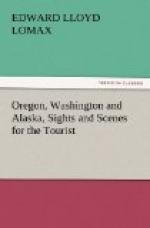miles by six, which is fed by the St. Joseph, St. Mary
and Coeur d’Alene Rivers, and which flows through
a vast plain until it empties its waters into the
Columbia, the Mississippi of the Pacific Coast.
From its point of junction with the Spokane, the Columbia
makes a big bend in its course until the Snake River
is reached, when it turns once more westward, and
flows on to empty into the Pacific Ocean. South
of the city, stretching westward for some distance
from the mountains, and extending in a southerly direction
to the Clearwater and Snake Rivers, is a vast country
comprising millions of acres, through which the Palouse
River and its tributary streams meander, and which
is known as the Palouse Valley, a country of unlimited
agricultural resources. In the center of all this
immense territory is located Spokane Falls, like the
hub in the center of a wheel. The word immense
is not used unwittingly, for the mountains and plains
and valleys make up a country that in Europe would
be called a nation, and in New England would form
a State. Only a far-off corner of the Union,
it may seem to some readers, yet there are powerful
empires which possess less natural resources than
it can call its own. The city itself lies on
both sides of the Spokane River, at the point where
that stream, separated by rocky islands into five
separate channels, rushes onward and downward, at
first being merely a series of rapids, and then tumbling
over the rocks in a number of beautiful and useful
waterfalls, until the several streams unite once again
for a final plunge of sixty feet, making a fall of
157 feet in the distance of half a mile. This
waterfall, with its immense power, would alone make
a city; engineers have estimated its force at 90,000
horse-power, and it is so distributed that it can
be easily utilized.
[Illustration: A fish wheel, Columbia
river. On the Union Pacific Ry.]
* * * *
*
Fourth Tour.—To
Alaska.
The native islanders called the mainland “Al-ay-ek-sa,”
which signifies “great country,” and the
word has been corrupted into “Alaska.”
This immense empire, it will be remembered, was sold
by Russia to the United States October 18, 1867, for
$7,500,000. The country was discovered by Vitus
Behring in 1741. Alaska has an area of 578,000
square miles, and is nearly one-fifth as large as
all the other States and Territories combined.
It is larger than twelve States the size of New York.
The best time to visit Alaska is from May to September.
The latter month is usually lovely, and the sea beautifully
smooth, but the days begin to grow short. The
trip occupies about twenty-five days.
As the rainfall in Alaska is usually very large, it
naturally follows that an umbrella is a convenient
companion. A gossamer for a lady and a mackintosh
for a gentleman, and heavy shoes, and coarse, warm
and comfortable clothing for both should be provided.




